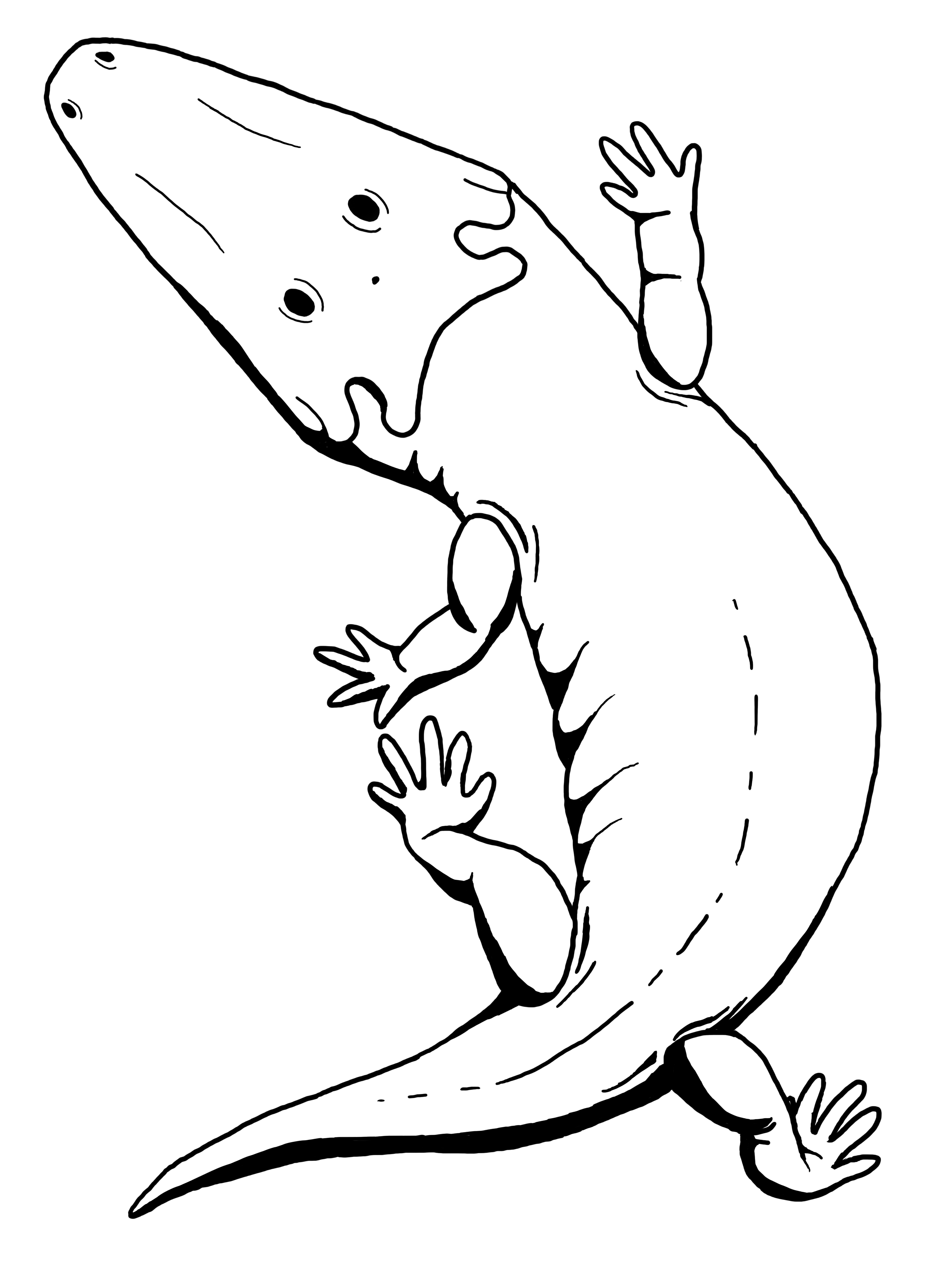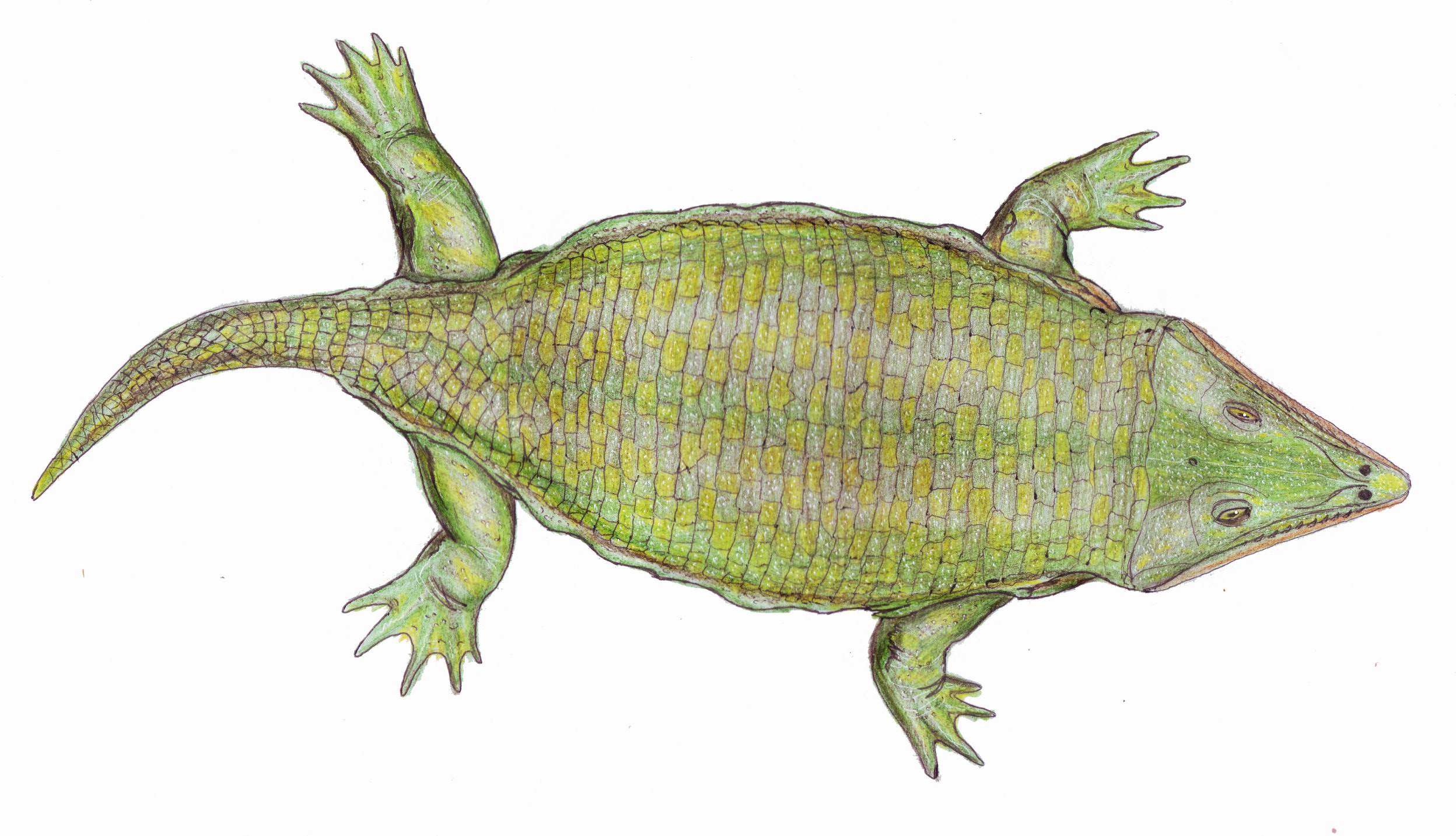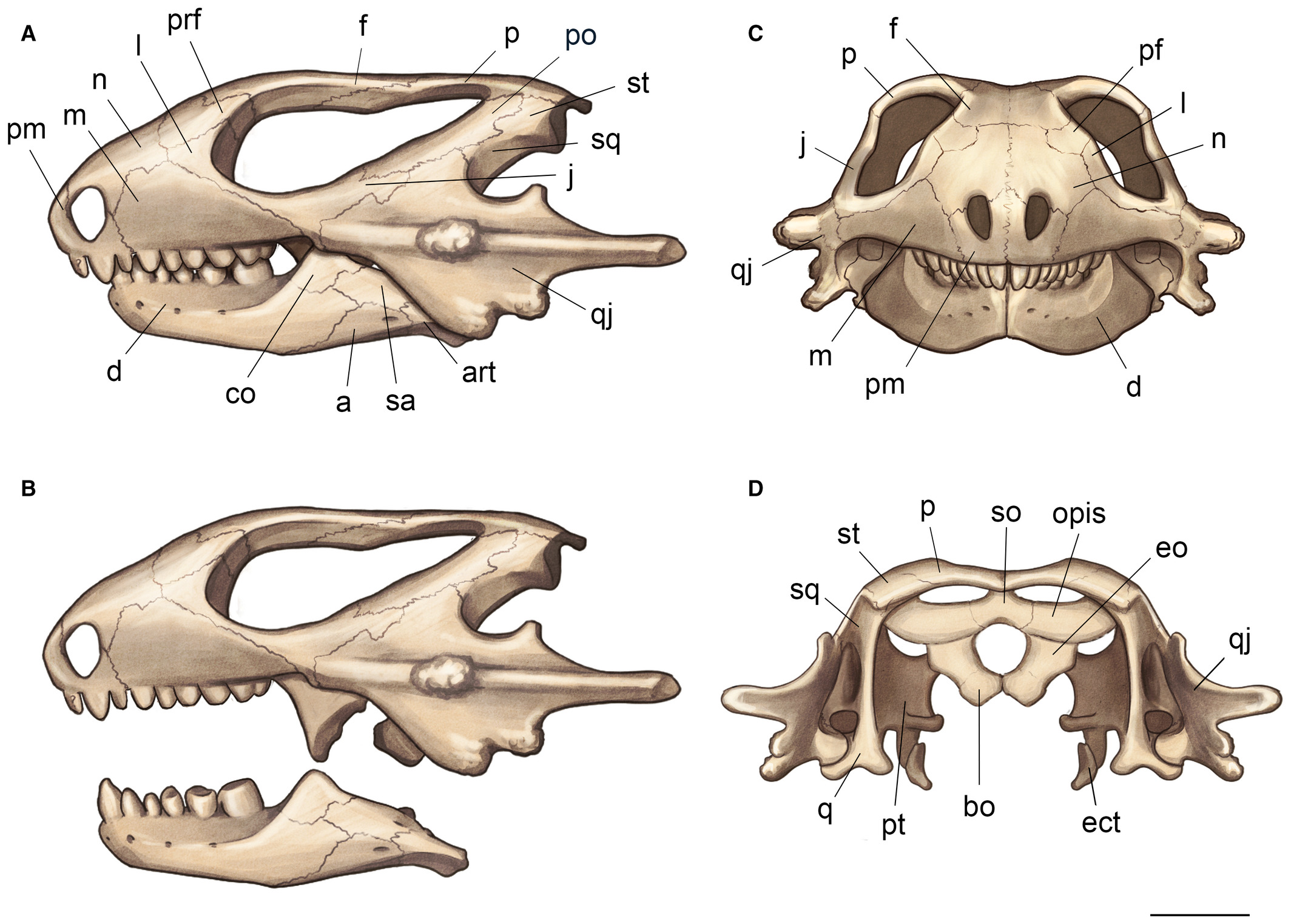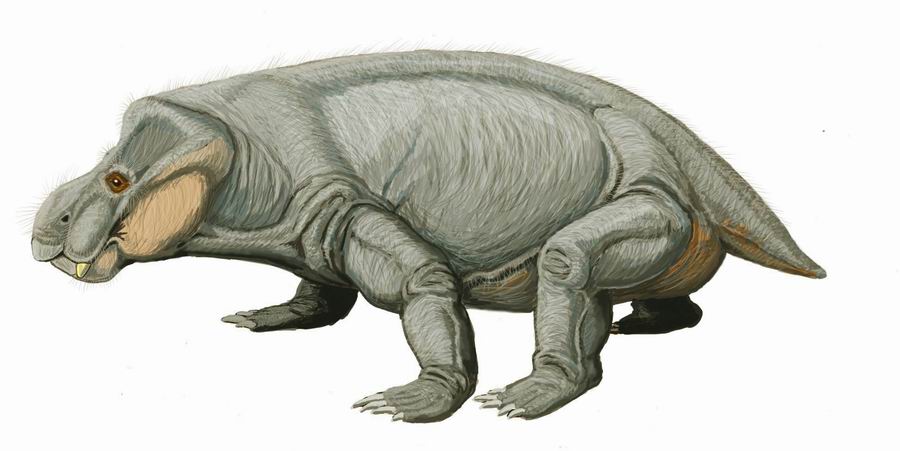|
Eohyosaurus
''Eohyosaurus'' is an extinct genus of basal rhynchosaur known from the early Middle Triassic (early Anisian stage) Burgersdorp Formation of Free State, South Africa. It contains a single species, ''Eohyosaurus wolvaardti''. Discovery ''Eohyosaurus'' is known solely from the holotype SAM-PK-K10159, a partial skull missing the front end, with associated incomplete lower jaws currently housed at the Iziko South African Museum, Cape Town. The specimen was discovered by Frederik Petrus Wolvaardt in December 2000, loose on boulder-strewn slopes at the base of a cliff, at Farm Lemoenfontein 44, Rouxville District of the Free State Province. It was collected from the middle deposits of the Burgersdorp Formation of Beaufort Group. This horizon belongs to Subzone B of the ''Cynognathus'' Assemblage Zone, dating to the early Anisian stage of the early Middle Triassic period, about 246 million years ago. Farm Lemoenfontein 44 also yielded remains of the archosauriform ''Erythrosuchus ... [...More Info...] [...Related Items...] OR: [Wikipedia] [Google] [Baidu] |
Rhynchosaur
Rhynchosaurs are a group of extinct herbivorous Triassic archosauromorph reptiles, belonging to the order Rhynchosauria. Members of the group are distinguished by their triangular skulls and elongated, beak like premaxillary bones. Rhynchosaurs first appeared in the Middle Triassic or possibly the Early Triassic, before becoming abundant and globally distributed during the Carnian stage of the Late Triassic. Description Rhynchosaurs were herbivores, and at times abundant (in some fossil localities accounting for 40 to 60% of specimens found), with stocky bodies and a powerful beak. Early primitive forms, like '' Mesosuchus'' and ''Howesia'', were generally small and more typically lizard-like in build, and had skulls rather similar to the early diapsid '' Youngina'', except for the beak and a few other features. Later and more advanced genera grew to medium to medium large size, up to two meters in length. The skull in these forms were short, broad, and triangular, becoming ... [...More Info...] [...Related Items...] OR: [Wikipedia] [Google] [Baidu] |
Cynognathus Assemblage Zone
The ''Cynognathus'' Assemblage Zone is a tetrapod biozone utilized in the Karoo Basin of South Africa. It is equivalent to the Burgersdorp Formation, the youngest lithostratigraphic formation in the Beaufort Group, which is part of the fossiliferous and geologically important Karoo Supergroup. The '' Cynognathus'' Assemblage Zone is the youngest of the eight biozones found in the Beaufort Group, and is considered to be late Early Triassic (Olenekian) to early Middle Triassic (Anisian) in age (around 247 Ma). The name of the biozone refers to '' Cynognathus crateronotus'', a large and carnivorous cynodont therapsid which occurs throughout the entire biozone. History The first fossils to be found in the Beaufort Group rocks that encompass the current eight biozones were discovered by Andrew Geddes Bain in 1856. However, it was not until 1892 that it was observed that the geological strata of the Beaufort Group could be differentiated based on their fossil taxa. The initial under ... [...More Info...] [...Related Items...] OR: [Wikipedia] [Google] [Baidu] |
Burgersdorp Formation
The ''Cynognathus'' Assemblage Zone is a tetrapod biozone utilized in the Karoo Basin of South Africa. It is equivalent to the Burgersdorp Formation, the youngest lithostratigraphic formation in the Beaufort Group, which is part of the fossiliferous and geologically important Karoo Supergroup. The ''Cynognathus'' Assemblage Zone is the youngest of the eight biozones found in the Beaufort Group, and is considered to be late Early Triassic (Olenekian) to early Middle Triassic (Anisian) in age (around 247 Ma). The name of the biozone refers to ''Cynognathus crateronotus'', a large and carnivorous cynodont therapsid which occurs throughout the entire biozone. History The first fossils to be found in the Beaufort Group rocks that encompass the current eight biozones were discovered by Andrew Geddes Bain in 1856. However, it was not until 1892 that it was observed that the geological strata of the Beaufort Group could be differentiated based on their fossil taxa. The initial undertak ... [...More Info...] [...Related Items...] OR: [Wikipedia] [Google] [Baidu] |
Howesia Browni
''Howesia'' is an extinct genus of basal rhynchosaur from early Middle Triassic (early Anisian stage) deposits of Eastern Cape, South Africa. It is known from the holotype SAM 5884, a partial skeleton with palate and partial lower jaws and from two paratypes, SAM 5885 and SAM 5886. It was found in the Burgersdorp Formation of the middle deposits of the Beaufort Group (Karoo Basin) and referred to Subzone B of the Cynognathus Assemblage Zone. It was first named by Robert Broom in 1905 and the type species In zoological nomenclature, a type species (''species typica'') is the species name with which the name of a genus or subgenus is considered to be permanently taxonomically associated, i.e., the species that contains the biological type specimen ... is ''Howesia browni'', named after Alfred Brown. References Rhynchosaurs Middle Triassic reptiles of Africa Anisian life Fossils of South Africa Fossil taxa described in 1905 Taxa named by Robert Broom Prehistori ... [...More Info...] [...Related Items...] OR: [Wikipedia] [Google] [Baidu] |
Middle Triassic
In the geologic timescale, the Middle Triassic is the second of three epochs of the Triassic period or the middle of three series in which the Triassic system is divided in chronostratigraphy. The Middle Triassic spans the time between Ma and Ma (million years ago). It is preceded by the Early Triassic Epoch and followed by the Late Triassic Epoch. The Middle Triassic is divided into the Anisian and Ladinian ages or stages. Formerly the middle series in the Triassic was also known as Muschelkalk. This name is now only used for a specific unit of rock strata with approximately Middle Triassic age, found in western Europe. Middle Triassic fauna Following the Permian–Triassic extinction event, the most devastating of all mass-extinctions, life recovered slowly. In the Middle Triassic, many groups of organisms reached higher diversity again, such as the marine reptiles (e.g. ichthyosaurs, sauropterygians, thallatosaurs), ray-finned fish and many invertebrate g ... [...More Info...] [...Related Items...] OR: [Wikipedia] [Google] [Baidu] |
Procolophonid
Procolophonidae is an extinct family of small, lizard-like parareptiles known from the Late Permian to Late Triassic that were distributed across Pangaea, having been reported from Europe, North America, China, South Africa, South America, Antarctica and Australia. The most primitive procolophonids were likely insectiovous or omnivorous, more derived members of the clade developed bicusped molars, and were likely herbivorous feeding on high fiber vegetation or durophagous omnivores. Many members of the group are noted for spines projecting from the quadratojugal bone of the skull, which likely served a defensive purpose as well as possibly also for display. At least some taxa were likely fossorial burrowers. While diverse during the Early and Middle Triassic, they had very low diversity during the Late Triassic, and were extinct by the beginning of the Jurassic. Phylogeny Below is a cladogram A cladogram (from Greek ''clados'' "branch" and ''gramma'' "character") is a di ... [...More Info...] [...Related Items...] OR: [Wikipedia] [Google] [Baidu] |
Kannemeyeria
''Kannemeyeria'' is a genus of dicynodont that lived during the Anisian age of Middle Triassic period in what is now Africa and South America. The generic name is given in honor of Dr. Daniel Rossouw Kannemeyer, the South African fossil collector who discovered the original specimen. It is one of the first representatives of the family, and hence one of the first large herbivores of the Triassic. Description ''Kannemeyeria'' was about in length, about the size of an ox. Although it had a large head, it was lightweight due to the size of the eye sockets and nasal cavity. It also had limb girdles which formed massive plates of bone that helped support its heavily built body. ''Kannemeyeria'' was well-adapted to living as a herbivore; it had a powerful beak and strong jaw muscles built for shearing plant material. ''Kannemeyeria'' had a massive head with unusually large openings for the eyes, nostrils and jaw muscles. It evidently tore up roots, stripped leaves from the vegeta ... [...More Info...] [...Related Items...] OR: [Wikipedia] [Google] [Baidu] |
Trirachodon
''Trirachodon'' (Greek: "three ridge tooth") is an extinct genus of cynodonts. Fossils have been found in the ''Cynognathus'' Assemblage Zone of the Beaufort Group in South Africa and the Omingonde Formation of Namibia, dating back to the Early and Middle Triassic. Description The skull of ''Trirachodon'' had a short, narrow snout with a wide orbital region. The zygomatic arches were relatively slender. ''Trirachodon'' was quite small for a cynodont, growing no larger than 50 cm in length. It had noticeably less molariform teeth than its closely related contemporary ''Diademodon''. These teeth tended to be transversely broader than ''Diademodon'' as well. A bony secondary palate and precise postcanine tooth occlusion are seen as derived characteristics in ''Trirachodon'' that are similar to those of mammals. Species The type species is ''T. berryi'', named in 1895 on the basis of a single cranial skeleton. Three other specimens were later referred to ''T. kannemeyeri'', wh ... [...More Info...] [...Related Items...] OR: [Wikipedia] [Google] [Baidu] |
Cynodont
The cynodonts () ( clade Cynodontia) are a clade of eutheriodont therapsids that first appeared in the Late Permian (approximately 260 mya), and extensively diversified after the Permian–Triassic extinction event. Cynodonts had a wide variety of lifestyles, including carnivory and herbivory. Mammals are cynodonts, as are their extinct ancestors and close relatives, having evolved from advanced probainognathian cynodonts during the Late Triassic. All other cynodont lines went extinct, with the last known non-mammalian cynodont group, the Tritylodontidae, having its youngest records in the Early Cretaceous. Description Early cynodonts have many of the skeletal characteristics of mammals. The teeth were fully differentiated and the braincase bulged at the back of the head. Outside of some crown-group mammals (notably the therians), all cynodonts probably laid eggs. The temporal fenestrae were much larger than those of their ancestors, and the widening of the zygomatic ar ... [...More Info...] [...Related Items...] OR: [Wikipedia] [Google] [Baidu] |
Microgomphodon Oligocynus
''Microgomphodon'' is an extinct genus of therocephalian therapsid from the Middle Triassic of South Africa and Namibia. Currently only one species of ''Microgomphodon'', ''M. oligocynus'', is recognized. With fossils present in the ''Cynognathus'' Assemblage Zone (CAZ) of the Burgersdorp Formation in South Africa and Omingonde Formation of Namibia and ranging in age from late Olenekian to Anisian, it is one of the most geographically and temporally widespread therocephalian species. Moreover, its occurrence in the upper Omigonde Formation of Namibia makes ''Microgomphodon'' the latest-surviving therocephalian. ''Microgomphodon'' is a member of the family Bauriidae and a close relative of '' Bauria'', another South African bauriid from the CAZ. Like other bauriids, it possesses several mammal-like features such as a secondary palate and broad, molar-like postcanine teeth, all of which evolved independently from mammals. Description ''Microgomphodon'' has a short snout and l ... [...More Info...] [...Related Items...] OR: [Wikipedia] [Google] [Baidu] |
Bauriid
Bauriidae is an extinct family of therocephalian therapsids. Bauriids were the latest-surviving group of therocephalians after the Permian–Triassic extinction event, going extinct in the Middle Triassic. They are among the most advanced eutherocephalians and possess several mammal-like features such as a secondary palate and wide postcanine teeth at the back of the jaws (analogous to mammalian molars). Unlike other therocephalians, bauriids were herbivorous. They were also smaller than earlier members of the group. Two subfamilies are classified within Bauriidae: Nothogomphodontinae and Bauriinae. Description Bauriids have a dentition characteristic of herbivores with the exception of ''Nothogomphodon''. There are four incisors on either side of the upper jaw. Like other therocephalians, bauriids have moderately enlarged canines. The postcanine teeth behind the canines are broad. The postcanines of the upper and lower jaw fit tightly together as an adaptation to processing pl ... [...More Info...] [...Related Items...] OR: [Wikipedia] [Google] [Baidu] |



